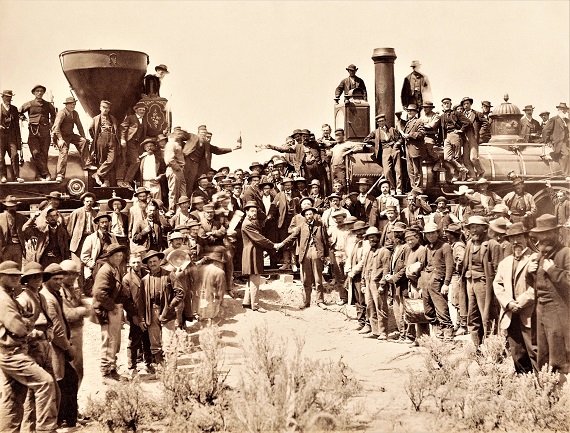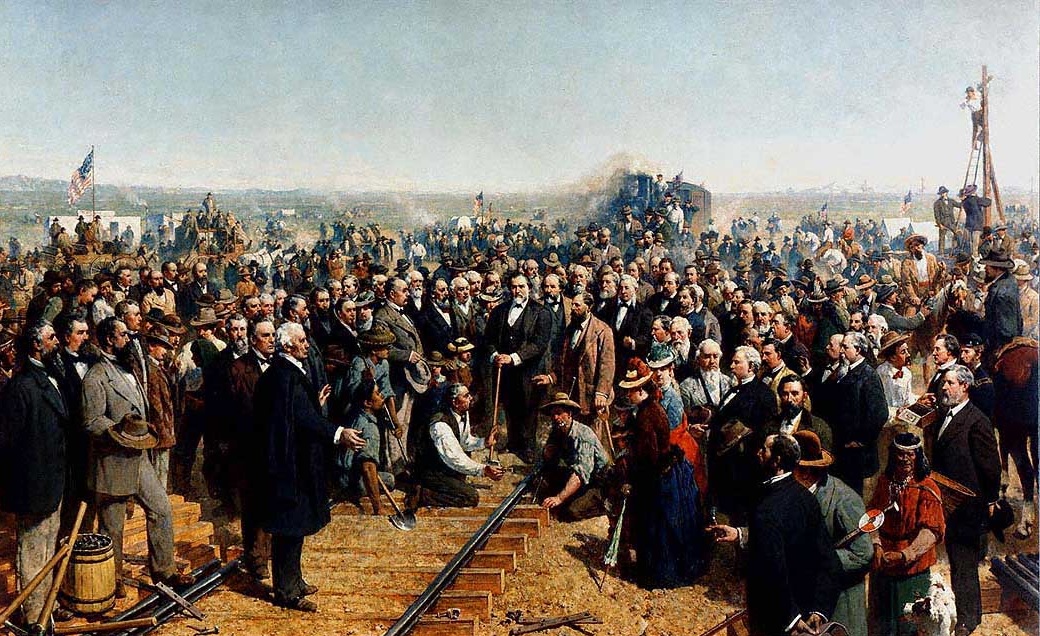Transcontinental Railroad Turns 150
The driving of the last spike of the Transcontinental Railroad at Promontory, Utah, on May 10, 1863, was a seminal event in U.S. history, capping decades of engineering triumph and human tragedy. Tens of thousands of laborers, many from China, carved tunnels and chiseled roadbeds through granite slopes of the Sierra Nevada so sheer that workers had to be suspended from 2,500 feet above.
The technological feat, reenacted annually at the Golden Spike National Historic Park, opened new commercial and telecommunication routes, stoked local, regional, and national economies, altered communities, and ushered in a new era of travel and migration.
The following resources, designed to mark the 150th anniversary of the fateful meeting of two steam locomotives, the Jupiter and No. 119, should help your students understand the historical impact of engineering and technology on society. (See the BBC article and photos from the 150th)

The U.S. Postal Service issued a set of commemorative stamps on the 150th anniversary of the driving of the Golden Spike.
LESSON PLANS AND ACTIVITIES
Lesson plans and activities from the National Education Association includes Learn Morse Code as well as links to videos such as the BBC five-part series on the Transcontinental Railroad.
Utah Education Network‘s Transcontinental Railroad activities and lesson plans for students in grades K- 7 include studying the environmental and local economic impact of the railroad.
PBS New Perspectives on the West [Grades 6-12] This lesson plan has students assess the need for a transcontinental railroad in the 1860’s.
EXHIBITS, LECTURES, AND OTHER EDUCATIONAL SOURCES
Golden Spike National Historical Site in Promontory Peak, Utah, hosts an annual historical re-enactment of the driving of the last spike. The website includes a history of the railroad and its impact on people and local economies.
The University of California-Davis marks the Transcontinental Railroad’s sesquicentennial with All Aboard! The exhibit, parts of which can be accessed online, includes 1936 footage of workers packing pears and loading them aboard the Pacific Fruit Express and vintage Eastman photographs.

Spike 150 lists Utah’s commemorative events.
The History Channel explores the role of the 15,000 to 20,000 Chinese workers who built the Transcontinental Railroad, including photos from work sites.
Thumbnail history of the Transcontinental Railroad from Montgomery College professor James Swartz includes background on the impact of the Industrial Revolution on the U.S.
The California State Railroad Museum commemorates the 150th anniversary of “one of the most pivotal events and achievements in history of the United States” with several new exhibitions.
The Transcontinental Railroad’s completion also inspired one of America’s most ambitious portrait projects: “The Last Spike,” by painter Thomas Hill. His 1888 painting includes 71 portraits of individuals who witnessed the May 10, 1869 event.
Filed under: Lesson Plans, Special Features, Web Resources
Tags: Civil Engineering, Class Activities, Golden spike 150th transcontinental railway, History, Internet Resources, Lesson Plan, Resources for Teachers, tracks, train, tunnels, Web Resources









